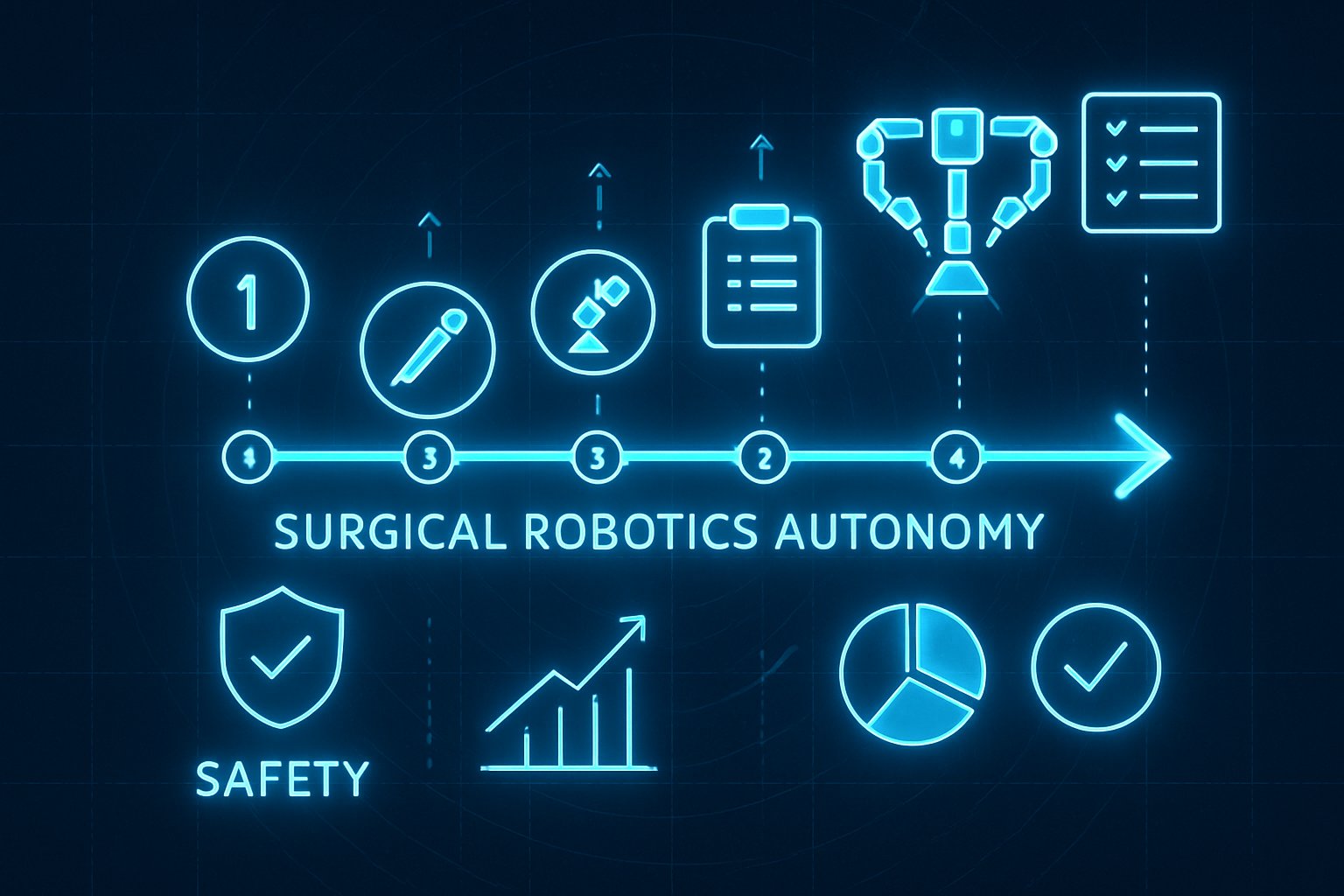
AI CERTS
2 days ago
Safety Claims Under Scrutiny In Surgical Robotics Milestone
Furthermore, we explore autonomy levels, leading platforms, benefits, and unresolved safety gaps. In contrast, peer-reviewed literature paints a nuanced picture of risk and reward. Meanwhile, secondary trends in Healthcare Automation and Precision Surgery continue reshaping hospital economics. Therefore, stakeholders require balanced insight to make strategic decisions. The following analysis delivers that balance with referenced facts and expert perspective.

Market Milestone Reality Check
Company press releases love round numbers. However, only CMR Surgical confirmed surpassing 10,000 Versius cases, without claiming flawless outcomes. Moreover, Intuitive Surgical logs millions of annual procedures yet never promises zero complications. Analysts note that public filings rarely quantify intraoperative adverse events. Consequently, the bold statement about Surgical Robotics performing 10,000 perfect procedures lacks audited support. Ultimately, professionals must distinguish volume milestones from validated safety records.
Volume data impress investors but not clinicians. Yet deeper evidence review is essential before accepting marketing claims.
Evidence Versus Bold Claims
Peer-reviewed studies rarely support absolute safety language. Additionally, systematic reviews find robotic complication rates comparable to conventional laparoscopy across several specialties. Regulatory databases record hundreds of device reports yearly, reflecting normal clinical variability. In contrast, vendor statements often reference "device-related complications," omitting patient-specific adverse events. Therefore, the touted zero-complication record for Surgical Robotics misrepresents the broader clinical reality. Nevertheless, smaller series do report pristine device safety, usually under 100 cases.
Researchers at Johns Hopkins achieved autonomous gallbladder removal on porcine tissue with full success. However, those trials involved eight specimens in controlled environments, not living humans. Consequently, extrapolating such findings to 10,000 human procedures remains premature. Meanwhile, Healthcare Automation journals call for modernized oversight as AI capabilities expand. Data gaps highlight the need for independent registries before bold statements gain acceptance. The next section clarifies autonomy levels and why terminology matters.
Autonomy Levels Explained Further
The LASR framework categorizes surgical autonomy from assistance to full independence. Moreover, 86% of cleared robots remain at Level-1 assistance, according to npj Digital Medicine. Only two devices list machine-learning functions in regulatory filings. Engineers still struggle with unpredictable bleeding and tissue compliance during automated maneuvers. Consequently, most marketed Surgical Robotics systems depend on continuous surgeon control.
Meanwhile, Level-3 conditional autonomy allows the robot to propose maneuvers but still awaits surgeon approval. Furthermore, fully autonomous human surgery remains experimental and faces ethical hurdles. Understanding these levels prevents confusion between smart assistance and genuine autonomy. Next, we examine how industry leaders integrate AI despite these limits.
Industry Leaders Pivoting AI
Intuitive Surgical added image-based guidance and analytics to the da Vinci line. Meanwhile, CMR Surgical markets cloud dashboards that benchmark Precision Surgery performance. Additionally, Levita Magnetics debuted an AI camera that autonomously centers the operative field. Consequently, competitive pressure accelerates AI upgrades across Surgical Robotics portfolios.
Moreover, hospitals pursuing Healthcare Automation favor platforms offering workflow analytics and predictive maintenance. In contrast, cost constraints push some centers toward modular upgrades rather than full replacements.
- Intuitive Surgical: 2.3–2.7 million annual procedures
- CMR Surgical: 10,000+ Versius cases announced 2023
- Levita Magnetics: first AI camera guidance case
- SS Innovations: transcontinental telesurgery demonstrations
Startups targeting orthopedics emphasize cloud-based coaching and real-time kinematic analysis. These innovators illustrate diverse strategies for mixing AI features with established robotic architectures. The following section explores benefits driving adoption despite cost concerns.
Benefits Driving Continued Adoption
Surgeons report better visualization and instrument dexterity during complex urologic and gynecologic cases. Moreover, meta-analyses show reduced conversion to open surgery in selected cohorts. Consequently, Surgical Robotics can support Precision Surgery by enabling steady motion and tremor filtration. Additionally, AI analytics flag workflow bottlenecks, boosting Healthcare Automation within the operating suite.
Hospitals also cite marketing advantages when recruiting tech-savvy patients and trainees. Furthermore, early postoperative data sometimes reveal shorter stays and lower transfusion rates. Cost savings may emerge long term through lower readmission rates and standardized supply usage. Together, these factors justify investment despite steep capital and maintenance costs. Yet advantages do not erase ongoing risks.
Persistent Risks And Gaps
Randomized trials frequently find no overall complication difference versus laparoscopic techniques. Nevertheless, operative times and per-case expenses often increase with Surgical Robotics deployments. Moreover, zero-complication claims usually exclude anesthesia events, bleeding, or surgeon errors. Consequently, regulators urge precise definitions before marketers reference flawless records. In contrast, patients may assume impossibly perfect outcomes once they hear such slogans.
Therefore, audited registries and transparent reporting remain critical for public trust. Meanwhile, autonomy research must progress through staged animal, cadaver, and Precision Surgery pilot studies. Ethicists caution that opaque algorithms could obscure accountability when complications occur. Risk awareness balances the optimism generated by rapid technical advances. Stakeholders now ask how to prepare for the next innovation wave.
Future Outlook And Preparation
Experts forecast incremental autonomy gains rather than overnight leaps to surgeon-less theaters. Consequently, multidisciplinary teams will refine algorithms while clinicians validate Surgical Robotics outcomes through pragmatic trials. Moreover, leaders can strengthen institutional readiness through targeted upskilling. Professionals may upskill via the AI Robotics certification.
Additionally, hospital administrators should benchmark Healthcare Automation maturity against peer institutions. Meanwhile, surgical departments can pilot Precision Surgery modules on low-complexity cases before wide deployment. Governments are drafting guidance to balance innovation incentives with rigorous patient protections. These preparatory steps position teams for continuous improvement as algorithms mature. The conclusion distills actionable insights and next steps.
Surgical Robotics continues evolving, yet verified safety data still trails optimistic marketing proclamations. However, evidence confirms rising procedure volumes and incremental AI autonomy across global hospitals. Moreover, Precision Surgery trends create new performance benchmarks for competitive institutions. Consequently, leaders must demand audited registries before announcing flawless records. Meanwhile, clinicians should master emerging tools to maximize patient benefit without overpromising outcomes. Additionally, targeted certifications accelerate readiness for the next phase of Surgical Robotics innovation. Therefore, visit the certification portal to advance skills and ensure safe, data-driven adoption. Future operating rooms will reward those who combine skepticism, evidence, and continuous learning.



